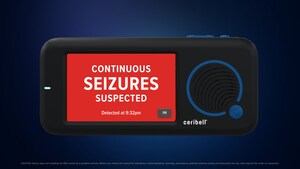The Ceribell™ Rapid Response EEG System Demonstrates Fast Seizure Diagnosis Leading To 40% Change In Physician Treatment Decisions
Data from a Prospective Observational Clinical Trial of Ceribell's Brain Stethoscope Published in Neurocritical Care Show Significant Improvement in Setup Time and Treatment Decision
MOUNTAIN VIEW, Calif., July 10, 2018 /PRNewswire/ -- Ceribell, Inc. announced that its Rapid Response EEG System provides significant improvement in setup time compared with conventional electroencephalography (EEG) and resulted in a significant net reduction in unnecessary treatments with anti-epileptic medication, according to data published in Neurocritical Care1.
Non-convulsive seizures, including cases of non-convulsive status epilepticus (NCSE), are common in critically ill patients in emergency departments and intensive care units (ICU). 90% of seizures in the ICU are non-convulsive2 and can only be detected by EEG. Prolonged non-convulsive seizures lead to permanent brain injury, and delayed diagnosis and treatment of NCSE leads to higher morbidity, mortality, and length of hospital stay3. The current guidelines from the Neurocritical Care Society4 recommend that continuous EEG should be initiated within 15-60 minutes of suspected status epilepticus in all patients. However, meeting this guideline has proven to be difficult due to the current limitations of EEG systems. The Ceribell Rapid Response EEG system was developed to address the limitations in EEG acquisition and interpretation.
In this study, 35 patient cases from ICU patients with altered mental status at Stanford University Hospital were assessed with Ceribell's proprietary Brain Stethoscope - a sonification feature that allows the clinician to easily differentiate between normal brain activity and a seizure. The mean setup time of the Ceribell system was 6 minutes. The median time from EEG order to recording with the conventional EEG was 145 minutes.
For patients with suspicion of seizure, treating physicians used standard evaluations to rate their suspicion for seizure and decided if the patient needed anti-epileptic drug (AED) treatment. After using the Ceribell Brain Stethoscope function, physicians reevaluated their suspicion for seizure and decision for additional treatment. The physicians' treatment decisions changed in approximately 40% of patients after listening to the Brain Stethoscope and resulted in a significant net reduction in unnecessary additional treatments (p=0.01). In addition, the Ceribell EEG System was consistently rated easy to use.
"These results demonstrate that the Ceribell EEG System has the potential to significantly improve the care that we provide to patients that we suspect of having a seizure. The reduced time to EEG and tools to improve our diagnosis will have a meaningful impact for both patients and care providers," said Kyle Hobbs, M.D.
"As we continue to drive innovation in the field of encephalography, we are excited to deliver our Rapid Response EEG System," said Jane Chao, CEO, Ceribell. "We have designed the Ceribell EEG System to meet the unmet needs of greater access, efficiency, and cost-effectiveness. This will be particularly beneficial for centers that do not have access to 24/7 EEG."
ABOUT THE CERIBELL RAPID RESPONSE EEG SYSTEM
The Ceribell Rapid Response EEG System consists of a 10-electrode (8-channel) headband, an EEG recorder with Brain Stethoscope feature, and a cloud portal for storing and reviewing EEGs.
The Ceribell EEG System received FDA 510(k) clearance in 2017 and is commercially available in the United States.
ABOUT CERIBELL
Ceribell, Inc. (www.ceribell.com), is headquartered in Mountain View, CA. Ceribell is focused on making EEG widely available, more efficient, and more cost-effective to improve the diagnosis and treatment of patients at risk for seizures.
1Hobbs, K., et al. Rapid Bedside Evaluation of Seizures in the ICU by Listening to the Sound of Brainwaves: A Prospective Observational Clinical Trial of Ceribell's Brain Stethoscope Function. Neurocrit Care (2018). https://doi.org/10.1007/s12028-018-0543-7
2Mecarelli, O. et al. EEG patterns and epileptic seizures in acute phase stroke. Cerebrovasc. Dis. 31, 191-198, doi:10.1159/000321872 (2011).
3Young GB, Doig GS. Continuous EEG monitoring in comatose intensive care patients: epileptiform activity in etiologically distinct groups. Neurocrit Care. 2005;2(1):5-10
4Neurocritical Care Society; Guidelines for the Evaluation and Management of Status Epilepticus, 2012
SOURCE Ceribell, Inc.
Related Links
WANT YOUR COMPANY'S NEWS FEATURED ON PRNEWSWIRE.COM?
Newsrooms &
Influencers
Digital Media
Outlets
Journalists
Opted In






Share this article